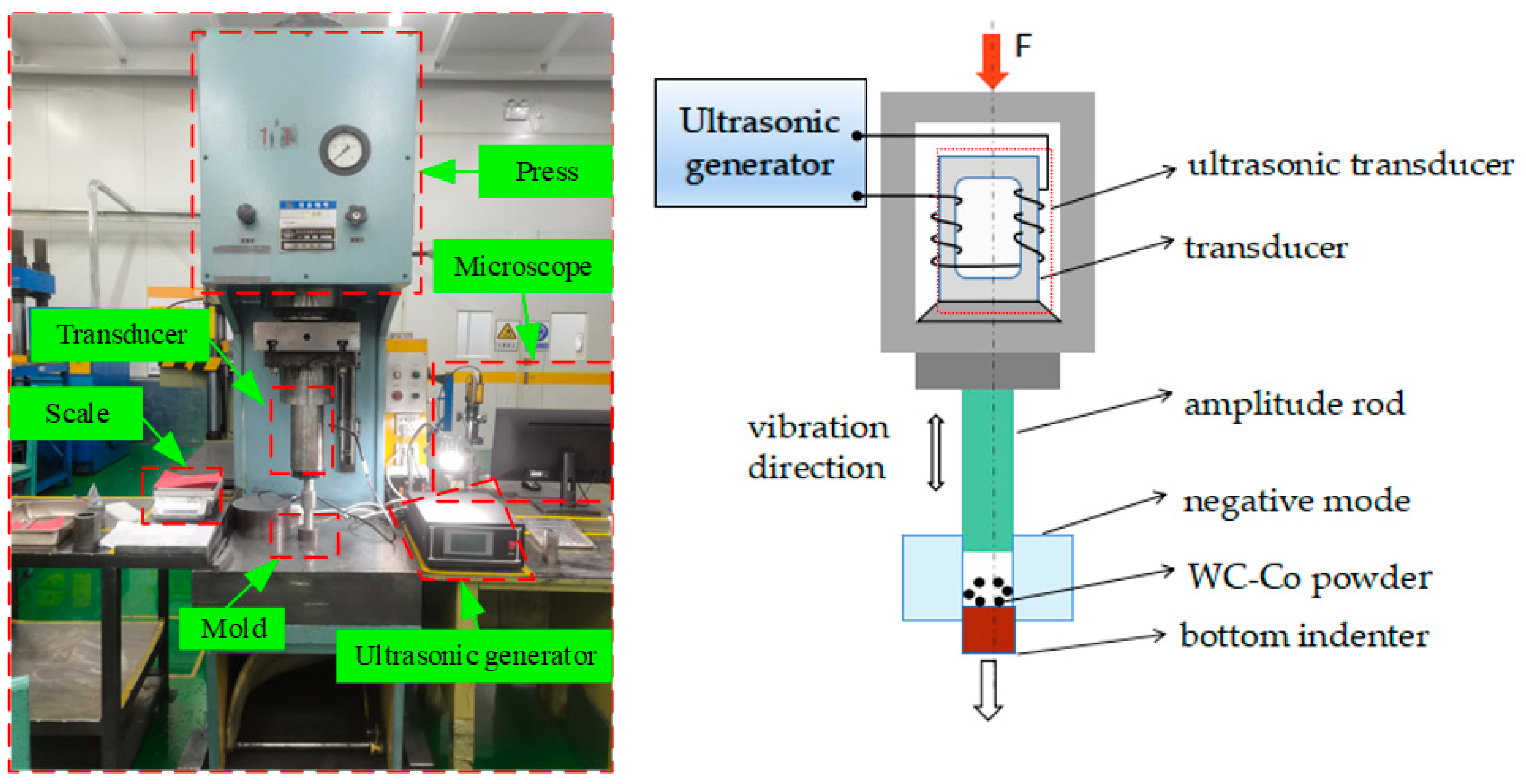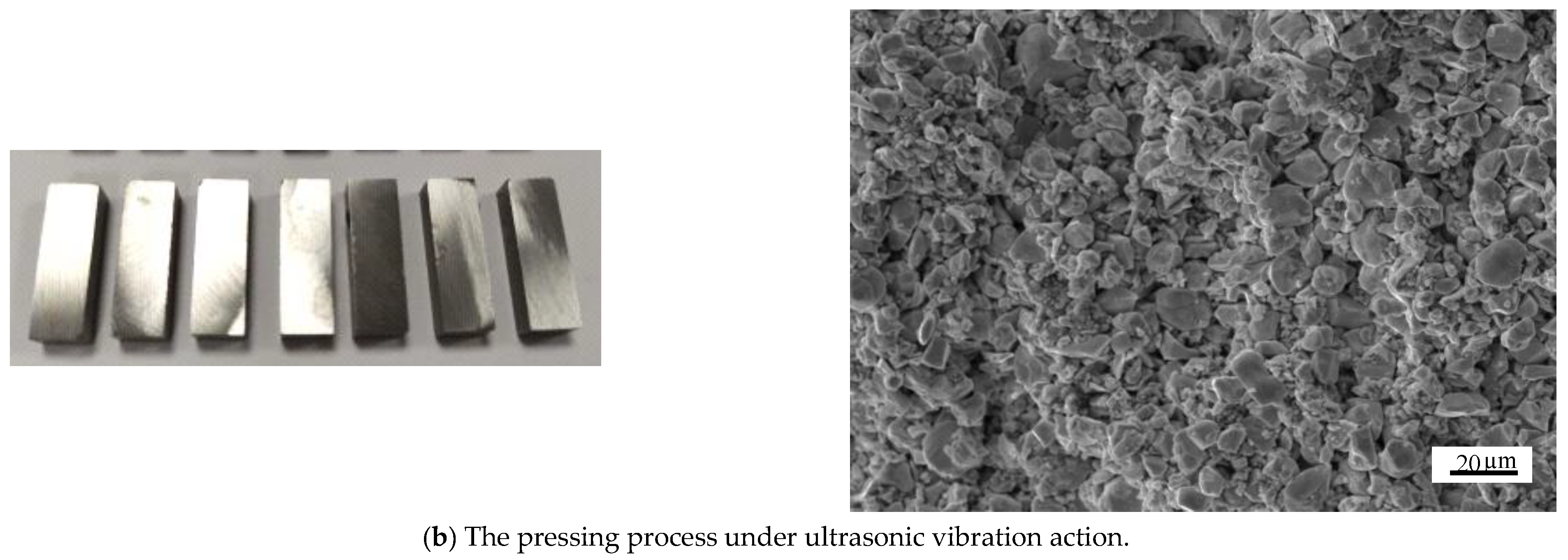Investigating the Microscopic Mechanism of Ultrasonic-Vibration-Assisted-Pressing of WC-Co Powder by Simulation
Abstract
:1. Introduction
2. Construction of the Experiment Platform
3. Construction of the Mathematical Model
4. Random Generation of Three-Dimensional Powder Particles
- ①
- To set the powder particle drop area, for example, randomly drop particles with radius R in a cube with length, width, and height of 10, as shown in Figure 5. Their spherical coordinates (x,y,z) must satisfy R ≤ x ≤ 10 − R, R ≤ y ≤ 10 − R, and R ≤ z ≤ 10 − R.
- ②
- To determine whether the randomly generated balls overlap:
- ③
- The number and density of particles generated must be set and controlled.
5. Simulation Model and Parameter Setting
5.1. Material Attributes
5.2. Analysis Step Setting and Meshing
5.3. Contact Properties and Boundary Conditions
6. Results
6.1. Analysis of Particle Flow under the Conventional and the Ultrasonic Vibration-Assisted Compression Processes
6.2. Effects of Ultrasonic Vibration Amplitudes on the Compact Density
6.3. Effects of the Ultrasonic Vibration on the Stress Distribution of the Compact
6.4. Experimental Verification
7. Conclusions
- (1)
- The influence of ultrasonic vibration amplitude on the compact density is great, so to obtain the theoretical results, values of vibration amplitudes were set 1, 2, and 3 μm to verify that the compact density increases gradually with the increase in ultrasonic amplitude. Especially in the early stage of particle deformation, the fluidity between particles is relatively intense, and the particles quickly fill the pores, so the filling density of the powder is significantly increased compared with that under conventional pressing conditions.
- (2)
- The use of ultrasonic vibration in powder pressing can effectively reduce the deformation stress between particles, reduce the residual stress in the compact after pressing, reduce the elastic after-effect, and improve the quality of the compact.
- (3)
- The obtained experimental results verify the developed theoretical model of the pressing process. When the value of the ultrasonic vibration amplitude is 3 μm, the finite element simulation is consistent with the experimental results, but when the density is greater than 5 g/cm3, the error between the experimental value and the simulation value is greater than 6%, mainly because the finite element simulation regards the friction coefficient between particles and between particles and the mold as a constant value during the particle-forming process, while the friction coefficient between particles and between particles and the mold constantly changes during the actual pressing process.
Author Contributions
Funding
Institutional Review Board Statement
Informed Consent Statement
Data Availability Statement
Acknowledgments
Conflicts of Interest
References
- Zhang, H.; Xiong, J.; Guo, Z.X.; Yang, T.E.; Yi, J.S.; Yang, S.D.; Liang, L. Influence of WC particle size on high temperature wear resistance of WC-Co cemented carbide. Hot Work. Technol. 2022, 51, 21–24. [Google Scholar]
- Wang, X.L.; Yong, W.; Peng Peng, H. Effect of Abrasive Material on Microstructure and Properties of WC-6% Co Cemented Carbide. Rare Met. Cem. Carbides 2022, 50, 89–95. [Google Scholar]
- Zhou, R.; Zhang, L.H.; He, B.Y.; Liu, Y.H. Numerical simulation of residual stress field in green power metallurgy compacts by modified Drucker–Prager Cap model. Trans. Nonferrous Met. Soc. China 2013, 23, 2374–2382. [Google Scholar] [CrossRef]
- Ding, Q.; Zheng, Y.; Ke, Z.; Zhang, G.T.; Wu, H.; Xu, X.Y.; Lu, X.P.; Zhu, X.G. Effects of fine WC particle size on the microstructure and mechanical properties of WC-8Co cemented carbides with dual-scale and dual-morphology WC grains. Int. J. Refract. Met. Hard Mater. 2020, 87, 105166. [Google Scholar] [CrossRef]
- He, R.; Li, B.; Ou, P.; Yang, C.H.; Yang, H.; Ruan, J.M. Effects of ultrafine WC on the densification behavior and microstructural evolution of coarse-grained WC-5Co cemented carbides. Ceram. Int. 2020, 46, 12852–12860. [Google Scholar] [CrossRef]
- Zhou, H.S.; Lu, K.Z.; He, J.H.; Yang, H.H.; Liu, C.Z. Research progress of ultrasonic compaction powder forming technology. Tech. Acoust. 2015, 34, 35–42. [Google Scholar]
- Wang, X.; Qi, Z.; Chen, W. Study on constitutive behavior of Ti-45Nb alloy under transversal ultrasonic vibration-assisted compression. Arch. Civ. Mech. Eng. 2021, 21, 1–15. [Google Scholar] [CrossRef]
- Zuo, M.M. Study on Dynamic Characteristics of Solid Particles under High-Frequency Vibration. Master’s Thesis, Yanshan University, Qinhuangdao, China, 2018. [Google Scholar]
- AlHazaa, A.; Haneklaus, N.; Almutairi, Z. Impulse Pressure-Assisted Diffusion Bonding (IPADB): Review and Outlook. Metals 2021, 11, 323. [Google Scholar] [CrossRef]
- Sliva, A.; Brazda, R.; Prochazka, A.; Martynkova, G.S.; Cech Barabaszova, K. Study of the optimum arrangement of sphericalparticles in containers having different cross section shapes. Nanosci. Nanotechnol. 2019, 19, 2717–2722. [Google Scholar]
- Zhao, Y.B.; Ma, L.; Liu, B.; Shang, Z.X. Vibration filling density analysis of pure iron powder based on discrete element method. Powder Metall. Technol. 2020, 38, 429–435. [Google Scholar]
- Wang, W.T.; Wang, J.Y.; Duan, N.Q.; Du, W.H. Study on influencing factors of powder vibration dense packing based on discrete element method. Chin. Ceram. 2013, 49, 42–45. [Google Scholar]
- Sedaghat, H.; Xu, W.; Zhang, L. Ultrasonic vibration-assisted metal forming: Constitutive modelling of acoustoplasticity and applications. J. Mater. Process. Technol. 2019, 265, 122–129. [Google Scholar] [CrossRef]
- Liu, B.; Ma, L.; Liu, Q.Z.; Lu, Y. Effect of EDEM based vibration characteristics on the filling density of NdFeB permanent magnetic powder. China Powder Sci. Technol. 2017, 23, 72–76. [Google Scholar]
- Korim, N.S.; Hu, L. Study the densification behavior and cold compaction mechanisms of solid particles-based powder and spongy particles-based powder using a multi-particle finite element method. Mater. Res. Express 2020, 7, 056509. [Google Scholar] [CrossRef]
- Wang, W.; Qi, H.; Liu, P.; Zhao, Y.B.; Chang, H. Numerical Simulation of Densification of Cu–Al Mixed Metal Powder during Axial Compaction. Metals 2018, 8, 537. [Google Scholar] [CrossRef] [Green Version]
- Luo, X.L. Study on Dynamic Mechanical Response of Metal Powder under Impact Loading Based on Three-Dimensional Discrete Element Method. Master’s Thesis, Ningbo University, Ningbo, China, 2018. [Google Scholar]
- Jia, Q.; An, X.Z.; Zhao, H.Y.; Fu, H.Y.; Fu, H.T.; Zhang, H.; Yang, X.H. Compaction and solid-state sintering of tungsten powders: MPFEM simulation and experimental verification. J. Alloys Compd. 2018, 750, 341–349. [Google Scholar] [CrossRef]
- Ren, X.; Li, Z.; Zheng, Y.; Tian, W.; Zhang, K.C.; Cao, J.R.; Tian, S.Y.; Guo, J.L.; Wen, L.Z.; Liang, G.C. High Volumetric Energy Density of LiFePO4 Battery Based on Ultrasonic Vibration Combined with Thermal Drying Process. J. Electrochem. Soc. 2020, 167, 130523. [Google Scholar] [CrossRef]
- Siegert, K.; Ulmer, J. Influencing the Friction in Metal Forming Processes by Superimposing Ultrasonic Waves. Cirp. Ann. Manuf. Technol. 2001, 50, 195–200. [Google Scholar] [CrossRef]
- Wang, W.T. Research on Numerical Simulation of Iron Powder Molding Based on Discrete Element Method. Ph.D. Thesis, Central North University, Taiyuan, China, 2014. [Google Scholar]
- Huang, P.Y. Principle of Powder Metallurgy M; Metallurgical Industry Press: Beijing, China, 1982. [Google Scholar]
- Bo, H.Y. Meso Simulation Study on the Influence of Interface Friction on Iron Powder Compaction. Master’s Thesis, Hefei University of Technology, Hefei, China, 2009. [Google Scholar]
- Ghafoor, S.; Li, Y.; Zhao, G.; Li, J.H.; Li, F.Y. Deformation characteristics and formability enhancement during ultrasonic-assisted multi-stage incremental sheet forming. J. Mater. Res. Technol. 2022, 18, 1038–1054. [Google Scholar] [CrossRef]
- Cheng, Z.N. Research on Deformation Mechanism and Microstructure Evolution of Ultrasonic Assisted Incremental Forming Materials. Master’s Thesis, Shandong University, Jinan, China, 2021. [Google Scholar]
- Wang, W.; Xiao, J.; Ran, Z.; Zheng, X.T.; Fu, B. Improvement of density of energetic materials based on ultrasonic assisted isostatic pressing. Energ. Mater. 2021, 29, 521–529. [Google Scholar]
- Chen, C.X. Quality Control Principle of Cemented Carbide M; Cemented Carbide Branch of China Tungsten Association: Zhuzhou, China, 2007. [Google Scholar]
















| Performance Parameter | ABAQUS Unit | Mold | WC | Co |
|---|---|---|---|---|
| Density | Tonne/mm3 | 7.89 × 10−9 | 1.56 × 10−9 | 7.9 × 10−10 |
| Modulus of elasticity | MPa | 2.09 × 105 | 7.14 × 105 | 2.09 × 105 |
| Yield strength | MPa | no | 2380 | 279 |
| Poisson’s ratio | no | 0.269 | 0.19 | 0.3 |
Disclaimer/Publisher’s Note: The statements, opinions and data contained in all publications are solely those of the individual author(s) and contributor(s) and not of MDPI and/or the editor(s). MDPI and/or the editor(s) disclaim responsibility for any injury to people or property resulting from any ideas, methods, instructions or products referred to in the content. |
© 2023 by the authors. Licensee MDPI, Basel, Switzerland. This article is an open access article distributed under the terms and conditions of the Creative Commons Attribution (CC BY) license (https://creativecommons.org/licenses/by/4.0/).
Share and Cite
Chen, Y.; Wang, Y.; Huang, L.; Su, B.; Yang, Y. Investigating the Microscopic Mechanism of Ultrasonic-Vibration-Assisted-Pressing of WC-Co Powder by Simulation. Materials 2023, 16, 5199. https://doi.org/10.3390/ma16145199
Chen Y, Wang Y, Huang L, Su B, Yang Y. Investigating the Microscopic Mechanism of Ultrasonic-Vibration-Assisted-Pressing of WC-Co Powder by Simulation. Materials. 2023; 16(14):5199. https://doi.org/10.3390/ma16145199
Chicago/Turabian StyleChen, Yuhang, Yun Wang, Lirong Huang, Binbin Su, and Youwen Yang. 2023. "Investigating the Microscopic Mechanism of Ultrasonic-Vibration-Assisted-Pressing of WC-Co Powder by Simulation" Materials 16, no. 14: 5199. https://doi.org/10.3390/ma16145199





